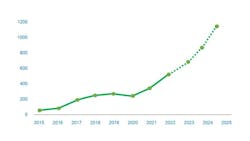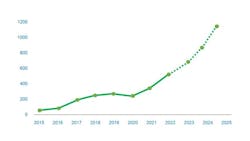APOLAN marks a decade of optical LAN advocacy by looking to the future
By Alan Bertsch and Brianne Scott, APOLAN
Throughout optical local area network’s (LAN) early history, delivering data to end users with fiber cabling was largely reserved for military and similar government entities that demanded highly secured networks. When a few innovative networking manufacturers recognized how well the technology could transform enterprise markets and began offering passive optical networking solutions to additional verticals, the passive optical LAN landscape slowly began to evolve. As they sought to promote passive optical LAN’s benefits, these companies understood the need for a unified voice, and the Association for Passive Optical LAN (APOLAN) concept was born.
In February 2013, Corning, IBM, SAIC, TE Connectivity, Tellabs, Zhone, and 3M agreed to form APOLAN. One month later, it held its first meeting to choose leaders, establish its mission and draft bylaws.
Bold beginning
“The last bastion for fiber is the horizontal portion of the local area network, and we’re going to take it,” APOLAN’s first chairman Dave Cunningham, then-manager of passive optical LAN marketing for Corning, told Enterprise Networking Planet when discussing the organization’s formation in 2013. “In the next couple of years, we will see people looking at this technology as at parity with the technology in wide use now.”For the past decade, Cunningham’s prediction has been playing out. Today, optical LAN is a nearly $600-million industry, and adoption is growing worldwide, according to the 2022 Building Services Research and Information Association (BSRIA) Optical LAN Global Market Report.
As optical LAN adoption has evolved, so too has APOLAN. The original membership base of manufacturers has expanded to include architects, engineers, consultants, integrators, designers and installers.
BICSI and BSRIA
To spread the word about optical LAN, the organization engaged in valuable partnerships with other organizations, including BICSI and BSRIA.
APOLAN first hosted its two-day Fundamentals of Passive Optical LAN seminar as part of the BICSI Fall Conference in 2015. Since then, APOLAN has delivered its master class at BICSI’s annual fall and winter conferences. This educational seminar provides an overview of optical LAN technology’s value, architecture, design and powering considerations. The presentation focuses on system components, benefits, design methodologies, power survivability using AC and DC methods, planning and commissioning of electronics, infrastructure testing and closeout package deliverables.
APOLAN also holds its annual membership meeting, announces its annual member award winners and exhibits at BICSI’s conferences. This exposure has helped the association reach thousands of networking professionals.
“Our collaboration with BICSI has been a big accomplishment, contributing to APOLAN becoming a more mature association,” said 2023 APOLAN chair Gayla Arrindell, marketing development director—in-building networks for Corning. “BICSI is recognizable throughout the ICT industry because they drive certification for all the contractors. Having BICSI support the optical LAN industry and inviting us to be part of their conferences helps validate APOLAN’s role.”
In 2015, APOLAN also began working with BSRIA, a leading global provider of authoritative market reports, to provide valuable, independent insight regarding optical LAN’s global market size and scope. BSRIA had previously reported on optical LAN, but the partnership offered direct access to APOLAN members to help ensure data continuity and reliability.
“APOLAN’s credibility comes from having a consortium of many different people associated with the industry working in a nonbiased fashion to promote optical LAN, and BSRIA extended that,” said Jeff Van Horne, founder and president of UberData Networks. “BSRIA doesn’t have a vested interest in technology. Having such a reputable research firm report how much optical LAN is growing and what’s driving that growth has been extremely valuable.”
Remarkable market growth
When BSRIA conducted its 2015 study, the passive optical LAN market has an estimated value of $65 million. Top industries were military, government, healthcare and hotels. North America accounted for more than half of the global market, with Asia and Oceania coming in a distant second with just over 22%.
Nearly three years later, the 2018 edition of the study reflected faster growth than anticipated. BSRIA estimated the market’s value at the end of 2017 to be just under $200 million. Adoption had expanded worldwide, with Asia accounting for 27% of the market, North America falling to second with 24%, and Caribbean and Latin America coming in a close third at 21%. Government and military remained the top vertical with mixed-use buildings that combined housing, offices and retail uses, becoming the second-most-popular vertical.
BSRIA’s 2020 report highlighted continuing growth but at a slower pace. The study estimated the total market at the end of 2019 to be $280 million. The Asian, North American, and Caribbean and Latin American markets held about the same market share from the previous report. However, the mix of vertical markets adopting optical LAN had shifted, with office buildings and hotels combining for nearly 60% of the market, and government falling to third with 22%. The report anticipated delayed growth for at least the next two years due to the COVID-19 pandemic.While industry growth dipped slightly in 2020, it rebounded quickly and aggressively. From 2019 to the end of 2022, the total market value soared to $586 million at an unprecedented growth rate of 109%. The Asia market had the largest adoption rate by region, however the Americas and Europe contributed with strong growth too.
BSRIA’s latest 2023 global study attributed the rapid growth over the past three years to multiple factors. First, there has been an increase in awareness for optical LANs. Second, more verticals are now embracing the use of fiber inside buildings and across extended campuses. Finally, mounting pressure on environmental matters is driving companies to more-sustainable infrastructure choices like optical LAN.
“We are witnessing growth coming from several market segments that previously were not as relevant as they are now,” said Martin Chiesa, BSRIA senior consultant. “This is an undoubtedly promising sign for the future of optical LAN.”
Continued evolution
APOLAN has grown and evolved with the global optical LAN market over the past decade. In 2022, the association shifted from an all-volunteer organization when it retained Forius Association Management Services (AMS) to provide strategic association management support services. This move gave APOLAN association expertise and day-to-day management, allowing volunteers to focus on strategy and thought leadership to drive the organization forward.
Harnessing Forius AMS’s guidance and expertise, APOLAN transitioned to an integrated association management software system that includes a new apolanglobal.org website and improved delivery of member benefits.
In February 2023, the association took another significant step by rebranding and adopting a streamlined name and logo. The organization retired its Association for Passive Optical LAN moniker, choosing to be known simply as APOLAN. One of the reasons for the chance was to broaden the association’s focus to include all things fiber-related within buildings and across campuses, not only passive optical networking.By de-emphasizing its longtime concentration on passive technology, APOLAN seeks to play a greater role in the overall conversation about fiber-optic adoption. Rather than promoting only one type of technology, APOLAN can have greater reach and influence by embracing various ways of pushing fiber deep into buildings and across campuses.
For example, much of the marketplace discussion about wireless data delivery has centered around cellular vs. WiFi, while failing to recognize that fiber optics are the ideal solution to push virtually unlimited amounts of data to the antennas that fuel over-the-air technology. Again, through its expanded scope, APOLAN can provide valuable insight that helps drive better networking.
Another trend with great potential for optical LAN and APOLAN is the recent introduction of the Class 4 Fault Managed Power specification. Class 4’s power level is more than 5 times that of Class 2’s 100-Watt limit, allowing optical distances in excess of 1 mile while using a single-end power system.
As part of its desire to diversify and grow membership, APOLAN is also exploring global opportunities. In June 2023, APOLAN announced the formation of a new Caribbean and Latin America (CALA) Committee. This action reflects the industry’s potential throughout Mexico, Central America, South America and the Caribbean. Modeled after APOLAN’s long-standing European Committee, the CALA Committee will promote APOLAN, recruit members within its territory and offer recommendations to the APOLAN board of directors regarding international initiatives.
Optical LAN’s benefits are undeniable. Fiber-based enterprise LANs are more energy-efficient, use less material, and require less floor, rack and closet space than copper-based traditional LANs. It’s efficient, scalable, sustainable and flexible.
“More than ever, APOLAN is focused on welcoming everybody and encouraging others to jump on board to help advocate for optical LANs,” said 2023 APOLAN chair-elect John Hoover, marketing director for Tellabs. “We invite all of the other big players in the ICT industry, electrical contractors, architects, engineers—anyone interested in designing better buildings and campuses—to join us.”
More information about APOLAN and its work driving optical LAN education and adoption is available at apolanglobal.org.
Alan Bertsch is the chief executive officer of Qypsys and an APOLAN board member. Brianne Scott is APOLAN’s executive director.



